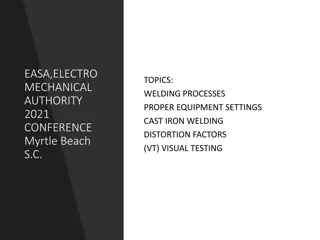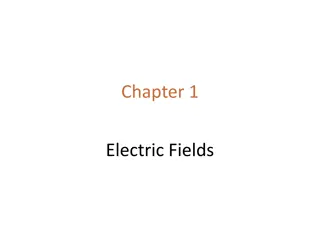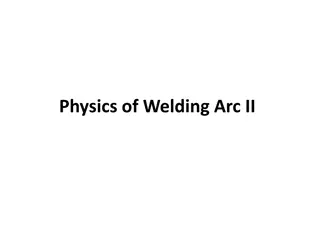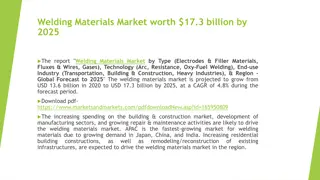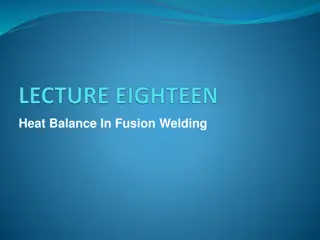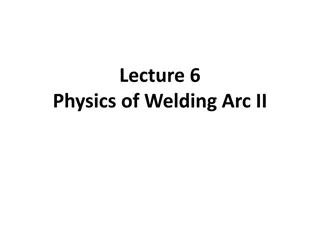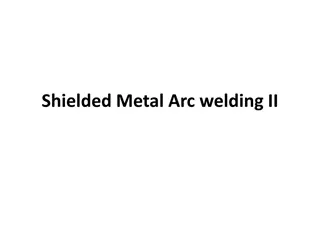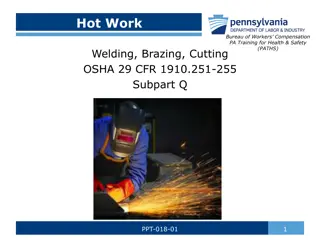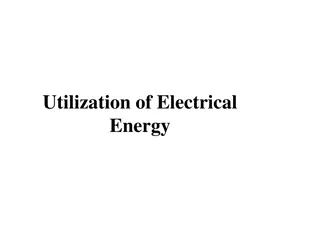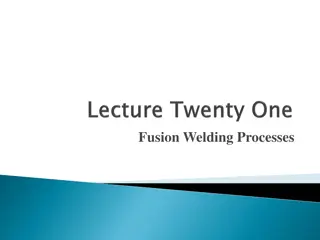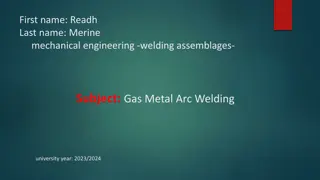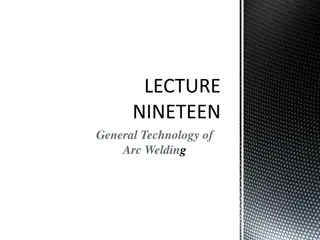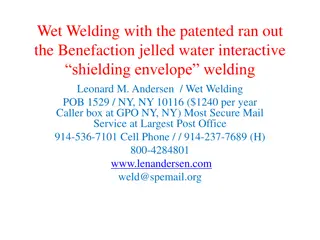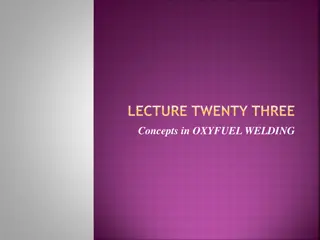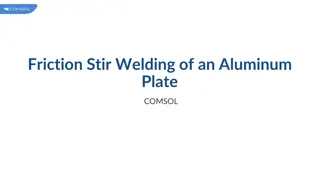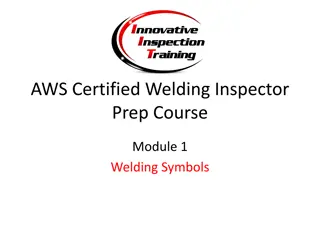Understanding Electric Arc Welding and Its Processes in Metal Joining
Electric arc welding is a vital process for joining metal pieces through the application of heat or pressure. This technique involves the melting of parent metal, and electricity plays a crucial role in generating the required heat. Different welding processes, such as fusion welding and non-fusion welding, are utilized depending on the application. The use of direct current (DC) is preferred for arc welding due to its efficiency and safety features. The production of an electric arc is essential for initiating the welding process, with various types of arc welding techniques and electrodes being used based on specific requirements.
Download Presentation

Please find below an Image/Link to download the presentation.
The content on the website is provided AS IS for your information and personal use only. It may not be sold, licensed, or shared on other websites without obtaining consent from the author. Download presentation by click this link. If you encounter any issues during the download, it is possible that the publisher has removed the file from their server.
E N D
Presentation Transcript
ELECTRIC ARC WELDING Y.MASTANAMMA ASSOCIATE PROFESSOR/HOD MCET,EEE
WELDING It is the process of joining two pieces of metal at faces rendering plastic or liquid by the application of heat or pressure or both. Filler material may be used to effect the union.
WELDING PROCESSES Two types: 1.Fusion welding: Involves melting of parent metal. eg:: carbon arc welding and gas welding. 2.Non-fusion welding: It does not involve the melting of parent metal. eg:: resistance welding.
ELECTRICITY IN WELDING Electricity is used in welding for generating heat at the point of welding in order to melt the material which fuses and forms the welding joint. Two most common methods for producing heat are: 1.Resistance welding: Here current is passed through the inherent resistance of the joint to be welded there by generating the heat. 2.Arc welding: Here electricity is conducted in the form of an arc which is established between the metallic surfaces.
Both the direct current (D.C) and alternating current(A.C) may be used for arc welding, but the direct current is preferred for most purposes. AC AND DC WELDING D.C WELDING A.C WELDING POWER SOURCE IS TRANSFORMER. POWER SOURCE IS TRANSFORMER RECTIFIER UNIT OR DC GENERATOR. A.C IS EASILY AVAILABLE AND DOES NOT PRODUCE NOISE. IT HAS LOWER OPEN CIRCUIT VOLTAGE,THEREFORE IT IS SAFER. IT POSSESS HIGH EFFICIENCY AND CONSUMES LESS ENERGY. IT CAN BE OPERATED IN FIELDS WHERE POWER SUPPLY IS NOT AVAILABLE.
ARC WELDING PRODUCTION OF ARC : An electric arc is formed whenever current is passed between two metallic electrodes separated by a short distance. Whenever electrode first touches the plate,a large short circuit flows and as it withdrawn later,current continues to flow in the form of spark across the air gap. Due to this spark,air gets ionized and air becomes conducting and so,current is able to flow across the gap. Temperature of arc welding flame is about 3100 c.
Types of arc welding: Unshielded arc welding:When a large electrode or filler rod is used for welding, it is said to be un- shielded arc welding. Shielded arc welding: When the welding rods coated with fluxing material are used, then it is called shielded arc welding. Electrodes An electrode is a tool used in arc welding to produce electric arc. Based on their characteristics, arc welding electrodes can be broadly classified into two types. They are: Consumable Electrode: If the melting point of an arc welding electrode is less, it melts and fills the gap in the workpiece. Such an electrode is called consumable electrode. Non-consumable electrode: If the melting point of the arc welding electrode is high, it does not melt to fill the gap in the workpiece. Such an electrode is called non-consumable electrode
Coated electrodes coated electrodes are being extensively used for shielded arc welding. They consist of a metal core wire surrounded by a thick flux coating applied by extrusion, winding or other processes. Electrode coating contributes a lot towards improving the quality of the weld. The principal advantages of using electrode coating are as under : 1.It stablizes the arc because it contains ionizing agents such as compounds of sodium and potassium. 2. It fluxes away impurities present on the surface being welded. 3. It forms slag over the weld which (i) protects it from atmospheric contamination (ii) makes it cool uniformly thereby reducing the changes of brittleness and (iii) provides a smoother surface by reducing ripples caused by the welding operation.
Welding flux is a combination of carbonate and silicate materials used in welding processes to shield the weld from atmospheric gases. When the heat of the weld zone reaches the flux, the flux melts and out gasses. The gases produced push the atmospheric gas back, preventing oxidation
Arc blow Arc blow is the, usually unwanted, deflection of the arc during arc welding. There are two types of arc blow commonly known in the electric welding industry: magnetic and thermal. Magnetic arc blow or "arc wander" : It is the deflection of welding filler material within an electric arc deposit by a buildup of magnetic force surrounding the weld pool. Arc blow tends to occur if the material being welded has residual magnetism at a certain level, particularly when the weld root is being made, and the welding current is direct current (DC positive or negative). This is due to interaction between the directional magnetic field of the welding arc and the directional field of the residual magnetism. Magnetic arc blow is popularly attributed to a change in the direction of current as it flows into and through the workpiece. It is experienced most when using currents above 200 A or below 40 A.
Thermal arc blow: It is widely attributed to variations in resistance within the base metal created by the weld pool as it is moved across the workpiece. Thermal arc blow can occur because of: 1.Improper surface preparation 2.Improper travel speed Due to arc blow, heat penetration in the required area is low which leads to incomplete fusion.Hence it is needed to be suppressed. Measures to avoid arc blow: Arc blow can be avoided by using a.c. rather than d.c. welding machines because reversing currents in the welding leads produce magnetic fields which cancel each other out thereby eliminating the arc blow. Reducing the rate of travel of the electrode. Shortening the arc column length etc.
Carbon arc welding Carbon arc welding was the first electric welding process. It s difference is that it uses non- consumable carbon or graphic electrodes instead of the consumable flux-coated electrodes. Graphite electrodes are harder, more brittle and last longer than carbon electrodes. They can withstand higher current densities but their arc column is harder to control. The main advantage of this process is that the temperature of the molten pool can be easily controlled by simply varying the arc length. Since arc serves only as a heat source, it does not transfer any metal to help reinforce the weld joint. The major disadvantage of the carbon-arc process is that blow holes occur due to magnetic arc blow especially when welding near edges of the workpiece.
Common types of arc welding used in practice: Shielded metal arc welding: Shielded metal arc welding (SMAW), also known as manual metal arc welding (MMA or MMAW), flux shielded arc welding or informally as stick welding, is a manual arc welding process that uses a consumable electrode covered with a flux to lay the weld.
Gas Shield Arc Welding: In this fusion process, welding is done with bare electrodes but weld zone is shielded from the atmosphere by a gas which is piped to the arc column. Shielding gases used are carbon dioxide, argon, helium, hydrogen and oxygen. No flux is required.
Resistance welding It is fundamentally a heat and squeeze process. The term resistance welding denotes a group of processes in which welding heat is produced by the resistance offered to the passage of electric current through the two metal pieces being welded. These processes differ from the fusion processes in the sense that no extra metal is added to the joint by means of a filler wire or electrode. Advantages: Some of the advantages of resistance welding are as under : Heat is localized where required No filler material is needed. Requires comparatively lesser skill Parent metal is not harmed Only disadvantage is with regard to high initial as well as maintenance cost.
Plasma Arc Welding : Basic Principle is It consists of a high-current electronic arc which is forced through a small hole in a water cooled metallic nozzle. The plasma gas itself is used to protect the nozzle from the extreme heat of the arc. The plasma arc is shielded by inert gases like argon and helium which are pumped through an extra passageway within the nozzle of the plasma torch. As seen, plasma arc consists of electronic arc, plasma gas and gases used to shield the jet column. Disadvantages: Since it uses more electrical equipment, it has higher electrical hazards.
Laser Welding: It uses an extremely concentrated beam of coherent monochromatic light i.e. light of only one colour (or wavelength). It concentrates tremendous amount of energy on a very small area of the workpiece to produce fusion. Some of the advantages of laser welding process are as follows : 1. It does not require any electrode. 2. It does not heat the workpiece except at one point. In fact, heat affected zone is virtually non-existent. 3.Liquidus is reached only at the point of fusion. 4.It produces minimal thermal distortion and shrinkage because area of heat-affected zone is the minimum possible.
Welding Transformers are used in AC machines to change alternating current from the power line into a low-voltage, high amperage current in the secondary winding. A combination of primary and/or secondary taps on the welding transformer are commonly used to provide a macro adjustment of the adjustment of secondary voltage. welding current, as well as Transformer ratings for AC machines are expressed in KVA (kilovolt-amperes) for a specified duty cycle. This duty cycle rating is a thermal rating, and indicates the amount of energy that the transformer can deliver for a stated percentage of a specific time period, usually one minute, without exceeding its temperature rating. The RMS Short Circuit Secondary Current specification indicates the maximum current that can be obtained from the transformer. Since heating is a function of the welding current, this parameter gives an indication of the thickness of the materials that can be welded.
Requirements/Ratings of a Welding Transformer: A welding transformer should satisfy the following requirements: 1. It should have a drooping static volt-ampere characteristic. 2. To avoid spatter, the surge of the welding current during a short- circuit should be limited to the least possible above the normal arc current. 3. The open circuit voltage should not normally exceed 80 volts and in no case 100 volts. 4. The output current should be controllable continuously over the full available range. 5. The open circuit voltage should be just sufficiently high for ready initiation of an arc and not too high to impair the economics of welding.



